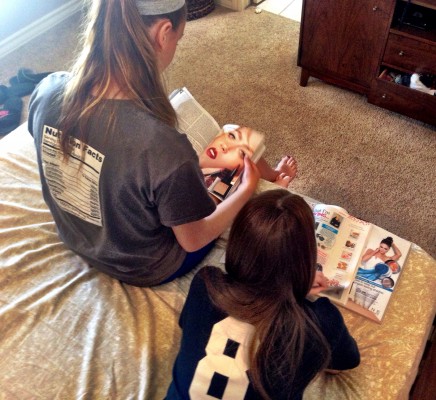Young girls such as Jordayn, 13 (left) and Patricia, 12, are being exposed to messages of ideal beauty through mediums like these popular magazines. Photo credit: Raquel Lopez
EL PASO — Tall, thin, light skinned, and flawless seem to be the description of ideal female beauty among younger generations.
An increasing concern in today’s society is the objectification of women in advertisement, media images that connect women to sex, and equate physical beauty with happiness.
According to the American Psychological Association (APA), sexualization is defined as when, “a person’s value comes only from his or her sexual appeal or behavior, to the exclusion of other characteristics; a person is held to a standard that equates physical attractiveness (narrowly defined) with being sexy.”
A person is sexually objectified, continues the APA definition, when they are “made into a thing for others’ sexual use, rather than seen as a person with the capacity for independent action and decision making; and/or sexuality is inappropriately imposed upon a person.”
Some ads geared to young teens, experts say, are examples of sexualization, and these images are not healthy for teenage girls.
“Girls develop their identities as teenagers and as women, and they learn the socially acceptable ways to engage in intimate relationships by modeling what they see older girls and young women doing and by imitating the ways in which women are represented in the media,” says the APA.
Yolanda Hernandez said she has noticed her 12-year-old daughter become more image conscious after entering 7th grade at Hornado Middle School.
“I have noticed she has started taking more pride in her appearance, looking for fashion blogs on YouTube and different ways to do her hair, requesting to wear a little bit of make up,” said Hernandez.
She believes that the mass media does have something to do with her daughters’ recent fixation on her looks.
“She loves Selena Gomez, she follows her and what she dresses like and what she is doing.. she looks up to her,” Hernandez said referring to the young pop star singer and actress.
She often reminds her daughter that the television images she sees of women are not reflective of who they really are.
“I tell her, it’s what is on the inside that counts. That is the true beauty,” she says.
A reality of modern society is that people are bombarded by advertisements daily, on billboards, social media, magazines and television. The average U.S. resident is exposed to about 3000 advertisements per day, according to Jean Killborne’s Killing Us Softly documentary.
In her documentary Killborne argues that because they are exposed to so many idealized images of women, girls often develop a stigma about their body type.
“Women learn from a very early age that we must spend enormous amounts of time, energy, and above all money striving to achieve this look and feeling ashamed and guilty when we fail,” said Kilborne in her short film.
Geralyn Rash says her 13-year-old daughter, Jordan, is already extremely conscious of her appearance.
“She is very aware of how she looks and how others perceive her,” said Geralyn Rash of her daughter.
Rash says Jordan believes she is “fat” because she is athletic, and not stick thin.
“She [Jordan] sees these girls, she watches Pretty Little Liars (a TV show) and they all look so tall and thin, and I think it really does affect her self esteem because she wants to look like that.”

Rash says when her daughter was six she began thinking about weight loss.
“Jordan… saw these weight loss commercials and would tell me she needed to go on a diet.”
Rash admits it’s not just her daughter who is affected. She too sometimes aspires to look like the thin, glamorous women she watches on TV. “I think we all get caught up in it.”
In her film, Killborne stresses that these media images of women are unhealthy and unrealistic. Some of the women in advertisements are made up of several women combined, she argues.
Although parents cannot control what their children are exposed to in the media, they are able to encourage them to be happy with themselves, which is what both Rash and Hernandez try to do with their daughters.
“Like I always say, be happy with yourself, “ Hernández says. “I want to encourage her that it is not about being skinny or fat, it’s about being healthy.”
Rash adds: “Beauty is only skin deep.” She reminds her daughter often that she is beautiful just as she is and encourages her to live a healthy and active life.
“At the end of the day, it comes down to loving who you truly are as a person,” she said.

